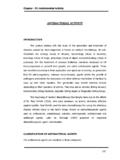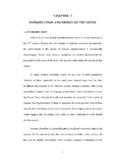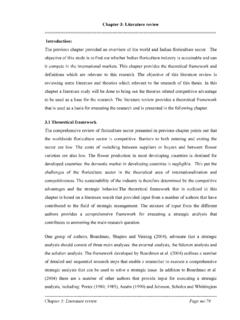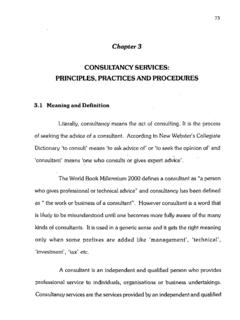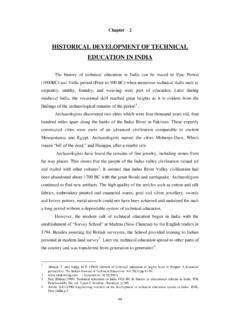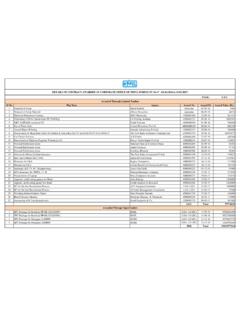Transcription of Chapter - 4 Privatization in Indian Economic
1 88 Chapter - 4 Privatization in Indian Economic Public Sector in the Indian Economy 89 Division of the Economy into Public and Private Sectors 89 Role of Public Sector in the Indian Economy 90 Problem of Public Sector Enterprise 100 Policy Towards Public Sector Since 1991 109 Role of the private sector in Indian economy 114 Role of the Private Sector 116 Private Sector in the Post in the Post Libera-lisation Phase 118 Problems of the Private Sector 123 Privatisation of Public Sector Enterprises : 128 The Disinvestment Programme in India Meaning and Rationale of Privatisation 128 Methods of Privatisation 130 Evolution of Privatization Policy in India 135 A Critique of Privatisation and Disinvestment 141 89 Public Sector in the Indian Economy14 The present Indian Economic structure is often characterised as 'mixed economy. There are two fields of production in the structure the private sector and the : sector.
2 The present Chapter is devoted to a discussion of issues pertaining to the public sector. In particular, we discuss: Division of the economy-into public and private sectors Role and performance of the public sector Problems of public sector enterprises Policy towards public sector since 1991. Division of the Economy into Public and Private Sectors At the time of Independence, activities of the public or were restricted to a limited field like irrigation, power, railways, ports, communications and some departmental undertakings. After Independence, the area of activities of the public sector expanded at a very rapid speed. To assure the private sector that its activities will not unduly curbed, two industrial policy resolutions were issued in 1948 and 1956 respectively. These policy resolutions divided the industries into different categories. Some fields were left, entirely for. the public sector, some fields were divided between the public and the private sector and some others were left totally to the private sector.
3 A cursory glance at the division of fields of industrial activity into the public and private sectors clearly brings out, that while heavy and basic industries were kept for the public sector, the entire field of consumer goods industries (having high and early returns) was left to the private sector. Outside the industrial field, while most of the banks, financial corporations, railways, air transport, etc., are in the public sector, the entire agricultural sector (which is the largest sector of the economy) has been left for the private sector. 14 Mishra & Puri, Indian Economy, 2010, Himalaya Publication. 90 The important point that arises at this juncture, is why were the heavy and basic industries like iron and steel, heavy engineering, heavy electrical plant, etc., selected for development in the public sector while quick-yielding consumer goods industries were left for the private sector?
4 The answer to this question has been attempted by R. K. Hazari according to whom the industrial programmes of government that emerged after 1955 were built around two hypotheses: (i)private investment in relatively simple goods would be promoted by shutting out imports as well as through excess capacity at home, with a consequent boost to profits; and (ii) public investment, being autonomous of profits, would take place in basic areas which had long gestation periods, low or no profits, a large foreign exchange component, complex technology and equally complex problems of co-ordination. The logic of the first hypothesis was that private investment was in the nature of 'induced investment' and could be promoted by adopting a policy of protection against imported substitutes. The logic of the second hypothesis was that investments in low profit yielding and heavy investment requiring industries were in the nature of 'autonomous investment' and could, accordingly, be undertaken only by the State.
5 Role of Public Sector in the Indian Economy Public sector in India has been criticized vehemently by a number of supporters of the private sector who have chosen to shut their eyes towards the achievements of the public sector. Following description should be sufficient to convince one that public sector has played a definite positive role in the economy. 1. Public sector and capital formation. The role of public sector in collecting savings and investing them during the planning era has been very important. During the first and second plans of the total investment, 54 per 91 cent was in the public sector and the remaining in the private sector. The share of public sector and the remaining in the private sector. The share of public sector rose to 60 percent in the third plan but fell thereafter. However, even then it was as high as per cent in the seventh plan. With increasing trends of liberalization in 1990s, the share of public sector in total investment fell drastically to per cent in the eighth plan ( , only one-third) and further to per cent in the Ninth Plan.
6 This reflects the increasing importance that is now being accorded to the private sector. The nationalized banks, State Bank of India, Industrial Development Bank of India, Industrial Finance Corporation of India, State Financial Corporations, LIC, UTI etc., have played an important role in collecting savings and mobilisation of resources. However, savings in the public sector itself are not much. In fact, there has been a precipitous fall in the share of public sector in gross domestic savings. During the period of Sixth Plan as a whole, public saving was per cent of total domestic saving and this fell to per cent during the period of the Seventh Plan and just per cent in the Eighth Plan (at 1999-2000 prices). During the first year of the Ninth Plan, 1997-98, share of public sector in total savings was just per cent. Savings in the public sector were negative in all other years of the Ninth Plan.
7 The first year of the Tenth Plan, , 2002-03 also recorded negative savings in the public sector. However, things have distinctly improved since. In 2003-04, savings in the public sector were Rs. 29,521 crore which rose significantly to Rs. 1,37,926 crore in 2006-07 and Rs. 2,12,543 crore in 2007-08. The share of public sector in total savings was per cent in 2003-04 which rose significantly to per cent in 2006-07 and further to per cent in 2007-08. The share of public sector in gross domestic capital formation (GDCF) which was per cent during Sixth Plan fell to per cent during Eighth Plan. It is estimated to have declined further to per cent in the Ninth Plan and per cent during the Tenth Plan. 2. Development of infrastructure. The primary condition of Economic development in any underdeveloped country is that the infrastructure should 92 develop at a rapid pace. Without a sufficient expansion of irrigation facilities and power and energy, one cannot even conceive of agricultural development.
8 In the same way without an adequate development of transportation and communication facilities, fuel and energy, and basic and heavy industries, the process of industrialization cannot be sustained. India had inherited an undeveloped basic infrastructure from the colonial period. After Independence, the private sector neither showed any inclination to develop it nor did it have any resources to make this possible. It was comparatively weak both financially and technically, and was incapable of establishing a heavy industry immediately. These factors made the State's participation in industrialization essential since only the 'government could enforce a large-scale mobilization of capital, the co-ordination of industrial construction, and training of technicians. The government has not only improved the road, rail, air and sea transport system, it has also expanded them manifold.
9 Thus the public sector has enabled the economy to develop a strong infrastructure for the future Economic growth. The private sector also has benefited immensely from these investments undertaken by the public sector. 3. Strong industrial base. The share of the industrial sector (comprising manufacturing, construction, electricity, gas and water supply) in Gross Domestic Product at factor cost has increased slowly but steadily during the period of planning. The share of the industrial sector in GDP at factor cost rose from per cent in 1950-51 to per cent in 1980-81 and further to per cent in 2008-09 (at 1999-2000 prices). This shows the increasing importance of the industrial sector in the Indian economy. Not only this, the industrial base of the Indian economy is now much stronger than what it was in 1950-51. There has been significant growth in the defense industries and industries of strategic importance.
10 The government has strengthened the industrial base considerably by placing due emphasis on the setting up of industries in the following fields iron and steel, heavy engineering, coal, heavy electrical machinery, petroleum and natural gas, chemicals and drugs, fertilizers, etc. Because of their low profitability potential in the short run, these industries do not find favour with the private sector. However, unless these 93 industries are set up, the consumer goods industries cannot progress at a sufficiently rapid pace. Therefore, the production of consumer goods industries in the private sector is also likely to suffer if the State does not invest in heavy and basic industries. As noted by Hanson, "Even the view that ; it is the function of the State to provide only basic 'services' leaves room for a great deal of public enterprise in manufacturing industry, as well as in power, transport, communications, etc.
